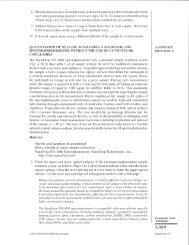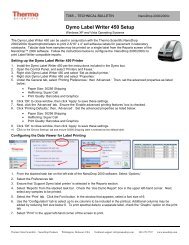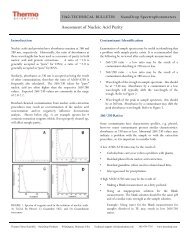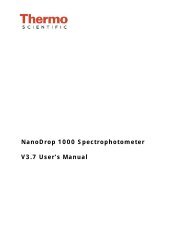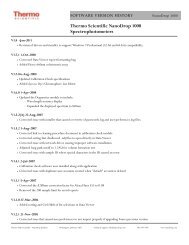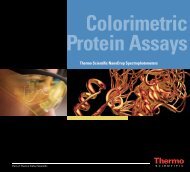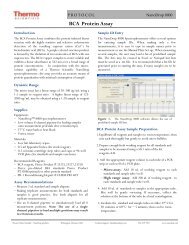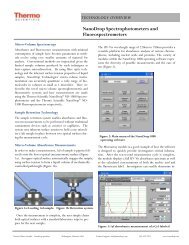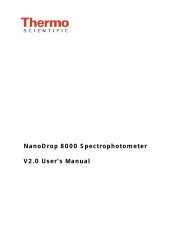Protein A280 - NanoDrop
Protein A280 - NanoDrop
Protein A280 - NanoDrop
- No tags were found...
You also want an ePaper? Increase the reach of your titles
YUMPU automatically turns print PDFs into web optimized ePapers that Google loves.
Thermo Scientific <strong>NanoDrop</strong> Spectrophotometers<strong>Protein</strong> <strong>A280</strong>ContentsIntroduction 4Sample Retention Technology 5Best Practices 6Cleaning & Reconditioning 6Instrument & Cuvette Orientation 7Sampling Technique 8Measurements 9Blank Measurements 9Sample Measurements 10Calculations 11Absorptivity 11Published Extinction Coefficients 13Sample Type Options 15Pathlength & Concentration 17Calibration 18Calibration Verification 18Standard vs Control 19Troubleshooting 20Common Reagents 20Unusual Spectra 21Reproducibility 22Instrument Related Issues 23Installation Errors 24Connection Errors 25Signal Errors 25FAQs 26Technical Support 29
Thermo Scientific <strong>NanoDrop</strong> Spectrophotometers<strong>Protein</strong> <strong>A280</strong>IntroductionSample RetentionTechnologyIntroduction• Pipette 1 – 2 μL sample directly onto the measurement pedestal.Tip: 0.5 μL aliquots may be used for samples that have 10 mm equivalent absorbance valuesof 3.0 or higher (> 4.5 mg/mL BSA). <strong>NanoDrop</strong> 2000/2000c model only.• Lower the sampling arm and initiate a spectral measurement using the software on the PC.• Surface tension is used to hold samples in place between two optical fibers.• Light from a xenon flashlamp passes through the top optical fiber, down through the liquidcolumn and is detected by the internal spectrometer.• When the measurement is complete, raise the sampling arm and wipe the sample from boththe upper and lower pedestals using a dry, lint-free laboratory wipe.Using this technology, <strong>NanoDrop</strong> spectrophotometers have the capability to measure samplesbetween 50 and 200 times more concentrated than samples measured using a standard1 cm cuvette.The <strong>Protein</strong> <strong>A280</strong> method is applicable to purified proteins that contain Trp, Tyr residues orCys-Cys disulphide bonds and exhibit absorbance at 280 nm. This method does not requiregeneration of a standard curve and is ready for protein sample quantitation at software startup.Colorimetric assays such as BCA, Pierce 660 nm, Bradford, and Lowry require standard curvesand are more commonly used for uncharacterized protein solutions and cell lysates.5
Thermo Scientific <strong>NanoDrop</strong> Spectrophotometers<strong>Protein</strong> <strong>A280</strong>Best PracticesCleaningReconditioning• An initial cleaning of both measurement surfaces with dH 2O is recommended prior to makingthe blank measurement. Do NOT use a squirt or spray bottle to apply water or any other liquidto the surface of the instrument.• Between measurements: Wipe the sample from both the upper and lower pedestals with aclean, dry, lint-free lab wipe.• A final cleaning of both measurement surfaces with dH 2O is recommended after the lastsample measurement. Do NOT use a squirt or spray bottle to apply water or any other liquid tothe surface of the instrument.• Additional cleaning: Use 3 µL of HCl instead of the dH 2O for cleaning when samples havedried on the pedestal. Follow with a 3 µL aliquot of dH 2O.• Detergents and isopropyl alcohol are NOT recommended cleaning agents as they mayuncondition the pedestal measurement surfaces. If a solution containing detergents oralcohol is used, follow with 3 – 5 µL of dH 2O.Use the <strong>NanoDrop</strong> Pedestal Reconditioning Compound (PR-1) as a rapid means of reconditioningthe pedestals when the hydrophobic surface properties have been compromised and liquidcolumns break during measurement.1. Open the vial containing PR-1 and use the applicator provided in the kit to remove apin-head sized amount of the compound.2. Apply a very thin, even layer of PR-1 to the flat surface of the upper and lower pedestals.Wait 30 seconds for the PR-1 to dry.3. Fold a clean, dry, lint-free lab wipe into quarters and remove the PR-1 by rubbing the surface ofthe upper and lower pedestals until no additional dark compound residue shows on the lab wipe.Pedestal AssessmentTo check the effectiveness of the reconditioning,pipet a 1 μL aliquot of dH 2O onto the lowermeasurement pedestal and visually verify thatthe water “beads up.”Droplet “flattens out” onunconditioned pedestalDroplet “beads up” onproperly conditioned pedestal6
Thermo Scientific <strong>NanoDrop</strong> Spectrophotometers<strong>Protein</strong> <strong>A280</strong>Best PracticesInstrument OrientationAngle the instrument for optimal pipetting.Right-handed orientation for the <strong>NanoDrop</strong> 2000/2000c and close-up view of the <strong>NanoDrop</strong> 8000.Below, recommended orientation for left- and right-handed sample dispensing on the <strong>NanoDrop</strong> 8000.Best PracticesCuvette Orientation(<strong>NanoDrop</strong> 2000c only)Use etched arrow as light path guide when inserting quartz or masked plastic cuvette.Tip: Locate instrument away from air currents and exhaust fans.7
Thermo Scientific <strong>NanoDrop</strong> Spectrophotometers<strong>Protein</strong> <strong>A280</strong>MeasurementsBlank MeasurementsPre-assessment of buffer compatibility with direct <strong>A280</strong> measurements:• Many buffers commonly used with protein samples contain components with significantabsorbance in the UV region. <strong>Protein</strong>s in these types of buffers may not be suitable for directquantitation using the <strong>A280</strong> method.• <strong>Protein</strong>s suspended in RIPA buffers may not be suitable for measurement using the <strong>A280</strong>application. It is recommended that a colorimetric assay such as Pierce 660 nm be used forproteins suspended in RIPA buffers. Refer to the reagent manufacturer for more informationregarding buffer compatibility.Follow the steps below to determine if your buffer exhibits significant absorbance in the regionof interest:1. Perform the Cleaning and Reconditioning procedures outlined in the Best Practicessection on page 6.2. Open the <strong>A280</strong> application. Load an aliquot of dH 2O onto the lower measurementpedestal and lower the sampling arm.3. Click Blank. After the measurement is complete, use a dry, lint-free lab wipe to removethe water from both the top and bottom measurement surfaces.4. Pipette an aliquot of the sample buffer onto the pedestal, lower the arm and clickMeasure. The result should be a spectrum that varies no more than 0.04 absorbance(10 mm absorbance equivalent) from the baseline at 280 nm. If not, consider using acolorimetric method to quantitate the protein samples.10mm Absorbance1.0 -0.8 -0.6 -0.4 -0.2 -0.0 -220 230 240 250 260 270 280 290 300 310 320 330 340 350Wavelength (nm)10mm Absorbance20 -15 -10 -5 -0 --2 -220 230 240 250 260 270 280 290 300 310 320 330 340 350Wavelength (nm)MeasurementsExample spectrum of buffer suitableExample spectrum of buffer suitablefor <strong>A280</strong> protein quantitationExample spectrum of buffer unsuitablefor use with <strong>A280</strong> protein quantitation5. If the buffer is compatible with the <strong>A280</strong> method, load a fresh aliquot of the buffer ontothe lower measurement pedestal and lower the sampling arm. Click Blank.6. After the measurement is complete, use a dry, lint-free lab wipe to remove the bufferfrom both the top and bottom measurement surfaces.Tip: Although it is not necessary to blank between each sample, it is recommendedthat a new blank be taken every 30 minutes when measuring many samples.9
Thermo Scientific <strong>NanoDrop</strong> Spectrophotometers<strong>Protein</strong> <strong>A280</strong>MeasurementsSample Measurements1. After the blank measurement is complete, enter the sample name in the Sample ID box, andchoose the appropriate sample type as described below:Sample Type OptionExtinction CoefficientBSA 6.67IgG 13.7Lysozyme 24.61 Abs = 1 mg/mL Default general reference settingE1% User-entered mass extinction coefficientE and MWUser-entered molar extinction coefficient and molecular weightRefer to Sample Types Options in the Calculationssection on pages 15 and 16 for more information.2. Pipette an aliquot of the protein sample onto the lower measurement pedestal and lower thesampling arm. Click Measure.Tip: If measuring more than one sample at a time on the <strong>NanoDrop</strong> 8000, it is important to use amulti-channel pipettor to deliver the sample aliquots.3. After the measurement is complete, use a dry, lint-free lab wipe to remove the sample fromboth the top and bottom measurement surfaces.4. Change pipette tips for the next measurement.Tip: If measuring multiple replicates of the same sample, it is important to use a fresh aliquot forevery measurement to ensure accurate results.5. Review spectral image to assess sample quality.60 -15 -10mm Absorbance40 -20 -10mm Absorbance10 -5 -0 -220 230 240 250 260 270 280 290 300 310 320 330 340 350Wavelength (nm)0 -220 230 240 250 260 270 280 290 300 310 320 330 340 350Wavelength (nm)High concentration BSA sampleLow concentration BSA sampleTip: Refer to the Troubleshootingsection on page 20 for more information.10
Thermo Scientific <strong>NanoDrop</strong> Spectrophotometers<strong>Protein</strong> <strong>A280</strong>CalculationsAbsorptivity• The best extinction coefficient value is one that isdetermined empirically using a solution of the studyprotein at a known concentration.Absorptivity is wavelengthspecific for each protein and canbe affected by buffer type, ionicstrength and pH.Tip: When determining extinction coefficients for aspecific protein, it is important to use the same bufferas will be used for the general assay.• Refer to the Pierce bulletin # TR0006.2 for additionalinformation regarding the use of Pierce standards tocalculate a “system-specific” extinction coefficient.<strong>Protein</strong> sample concentrationsare determined based on theabsorbance at 280 nm, theextinction coefficients determinedby the selected sample type anda baseline correction.• The correction normalizes for any baseline offsetattributable to light scattering artifacts. The defaultwavelength for the baseline normalization is 340 nm.Tip: The user may manually enter a differentwavelength to be used for the baseline normalizationwhen using the <strong>NanoDrop</strong> 2000/2000c.12
Thermo Scientific <strong>NanoDrop</strong> Spectrophotometers<strong>Protein</strong> <strong>A280</strong>CalculationsPublished ExtinctionCoefficientsConversions• The relationship between molar extinction coefficient(e molar) and percent extinction coefficient (e1%) isas follows:(e molar)* 10 = (e1%) × (molecular weight of protein)Example:Assume you want to determine the e1% for a proteinwhose molar extinction coefficient is 43,824 M -1 cm -1 anda molecular weight of 66,400 daltons. To determinethe e1% for this protein, rearrange the above equationas follows:e1% = (e molar*10) / (MW)e1% = (43,824*10) / (66,400 daltons)e1% = 6.6• To report concentrations in terms of mg/mL, an adjustmentfactor of 10 is used when using percent solution extinctioncoefficients. To convert from g/100 mL to mg/mL.(A / e1%) *10 = concentration in mg/mLExample:Assume you obtain an 280 nm absorbance reading of5.8A for a protein sample relative to your reference.To determine the calculated concentration of yoursample (mg/mL), refer to the equation below:C mg/mL= (A/ e1%) x 10C mg/mL= (5.8/6.6) x 10C mg/mL= 8.79 mg/mLTip: The <strong>NanoDrop</strong> software automatically includesthe factor of 10 when reporting protein concentrations.The information presented above is for explanationpurposes only.14
Thermo Scientific <strong>NanoDrop</strong> Spectrophotometers<strong>Protein</strong> <strong>A280</strong>CalculationsSample Type OptionsThere are six sample types (options) available for purified protein analysis and concentrationmeasurement using the <strong>A280</strong> application on the <strong>NanoDrop</strong> models specified at the beginning ofthis guide. A description of each sample type is given below:Representative Sample TypesBSA<strong>Protein</strong> concentrations arecalculated using the massextinction coefficient of 6.7 at280 nm for a 1% (i.e., 10 mg/mL)Bovine Serum Albumin solution.• Assuming a MW = 66,400 daltons, the molarextinction coefficient at 280 nm for BSA is approximately43,824 M -1 cm -1 .IgG<strong>Protein</strong> concentrations arecalculated using the massextinction coefficient of 13.7 at280 nm for a 1% (i.e., 10 mg/mL)IgG solution.• Most mammalian antibodies (i.e., immunoglobulins)have protein extinction coefficients (percent) in therange of 12 to 15.• For a typical IgG with MW = 150,000 daltons, thisvalue corresponds to a molar extinction coefficient(e) equal to 210,000 M -1 cm -1 .Lysozyme<strong>Protein</strong> concentrations arecalculated using the massextinction coefficient of 26.4 at280 nm for a 1% (i.e., 10 mg/mL)Lysozyme solution.• Molar extinction coefficient for egg white lysozymeranges from 36,000 to 39,000 M -1 cm -1 .15
Thermo Scientific <strong>NanoDrop</strong> Spectrophotometers<strong>Protein</strong> <strong>A280</strong>CalculationsSample Type OptionsOther Sample Types1 Abs= 1 mg/mlA general reference settingbased on a 0.1% (i.e., 1 mg/mL)protein solution producingan Absorbance at 280 nm of1.0 A (where the pathlengthis 10 mm or 1 cm).• Assume e1% = 10 if no extinction coefficient informationexists for a protein or protein mixture of interest and arough estimate of protein concentration is required for asolution that has no other interfering substances.• Most protein extinction coefficients (e1%) range from 4.0to 24.0. Although any given protein can vary significantlyfrom e1% = 10, the average for a mixture of manydifferent proteins will likely be approximately 10.Tip: This option is useful when measuring a proteinsolution for which no absorptivity information is available.Other protein (e + MW)The relationship between molarextinction coefficient (e molar)and percent extinction coefficient(e percent) is as follows:(e molar) 10 = (e percent) ×(molecular weight of protein).• Although the label of the field where one enters theextinction coefficient differs between <strong>NanoDrop</strong>models, e.g., e /1000 or e (x1000), the value enteredwould be the same. For example, for a protein with amolar extinction coefficient of 210,000 M -1 cm -1 , enter210 in the e window for all model types.• Enter the molecular weight in kilodaltons in theMW (kDal) field.Tip: Use this option when the molar extinctioncoefficient (M -1 cm -1 ) and molecular weight are known.Other protein (e1%)• Enter the mass extinction coefficient (L gm -1 cm -1 )for a 10 mg/mL (e1%) solution of the respectivereference protein.16
Thermo Scientific <strong>NanoDrop</strong> Spectrophotometers<strong>Protein</strong> <strong>A280</strong>TroubleshootingUnusual SpectraAbsorbanceAbsorbance1.00 -4 -2 -0 --2 --4 --6 --8 -220 230 240 250 260 270 280 290 300 310 320 330 340 350Wavelength (nm)0.90 -0.80 -0.70 -0.60 -0.50 -0.40 -0.30 -0.20 -0.10 -0.00 --0.10 -220 230 240 250 260 270 280 290 300 310 320 330 340 350Wavelength (nm)Negative values associated with some spectra indicate that either thepedestals were very dirty when the blank measurement was made or that asample was used to make a blank or reblank measurement.Suggestion:Clean pedestal and measure new blank.A ragged appearance throughout a spectrum may indicate a bad blank.Suggestion:Clean pedestal and measure new blank.Troubleshooting40 -Absorbance35 -30 -25 -20 -15 -10 -5 -0 --4 -220 230 240 250 260 270 280 290 300 310 320 330 340 350Wavelength (nm)A jagged appearance throughout a spectrum may indicate a broken column.Suggestions:Clean and recondition both measurement surfaces, then measure new blank.Increase sample volume to ensure proper column formation.Absorbance75 -60 -45 -30 -15 -0 -220 230 240 250 260 270 280 290 300 310 320 330 340 350Wavelength (nm)A jagged appearance at the top of the 280 mm peak most likely indicatesdetector saturation due to a highly concentrated sample.Suggestion:In cases like these, the data will be erroneous and should not be used fordownstream work. Dilute the sample and remeasure.21
Thermo Scientific <strong>NanoDrop</strong> Spectrophotometers<strong>Protein</strong> <strong>A280</strong>TroubleshootingReproducibilityNon-reproducible results are usually due to issues with sample non-homogeneity, blankingon a dirty pedestal, using the same aliquot for multiple measurements, or column breakage.Sample Heterogeneity• Sampling from non-homogeneous solutions, particularly whenusing small volumes, may result in significant measurementdeviation in the generated data.Dirty pedestal• Clean and recondition the pedestal surfaces prior to the start ofthe measurement session.• Follow the suggestions in the Blank Measurementssection onpage 9, prior to making sample measurements.Multiple Measurements• Use fresh aliquots for each pedestal measurement.Tip: Multiple measurements of the same aliquot may result inevaporation and increased sample concentration values.Column Breakage• Visually check that a column is intact after the completion of themeasurement. If not, refer to the Instrument Related Issuessection for guidance.22
Thermo Scientific <strong>NanoDrop</strong> Spectrophotometers<strong>Protein</strong> <strong>A280</strong>TroubleshootingReproducibilityConcentrations not withinExpected Range• Ensure samples fall within the linear detection range ofthe instrument.Tip: Refer to the table of model specific detection limits onpage 17 for guidance.• Ensure sample solution is homogeneous by gentle vortexing,as appropriate.• Confirm that the reference (blank) solution and sample solvent arethe same material.• Clean and recondition the pedestal surfaces prior to the start of themeasurement session.• Ensure appropriate sample type is selected, as concentrationcalculations utilize constants specific to each sample type.Instrument Related IssuesColumn Breakage• Ensure pedestal surfaces are properly conditioned.Tip: When a pedestal becomes unconditioned, sample dropletsapplied to the bottom pedestal will “flatten out” and cover the entirepedestal surface rather than “bead up.” Refer to the Reconditioninginstructions under the Best Practicessection on page 6.• Ensure sufficient volume is loaded onto the pedestal.• Use a larger volume (1.5 – 2 μL) for each measurement.• Use a calibrated small volume pipettor to deliver the sampleto the pedestal.• Ensure instrument is not located near a vent or other sourceof air flow.• Ensure measurements are made immediately after pipettingsamples onto the pedestal, as delays may compromise accuracy.• If an error message indicating possible column breakage isdisplayed and the user visually confirms that the liquid column isforming, perform a calibration check. If the instrument is out ofcalibration, contact Technical Support. Outside of the US andCanada, please contact your local <strong>NanoDrop</strong> products distributor.23
RNA: 40 ng-cm/µLAbsorbance = -log intensity sampleintensity blankssDNA: 33 ng-cm/µL(emolar)* 10 = (e1%) x (molecular weight of protein)dsDNA: 50 ng-cm/µLA = e* b * c(A / e1%) *10 = concentration in mg/mLc = (A * e)/b0.2 mm pathlengthc = A / e b1 Abs = 1 mg/mL
Thermo Scientific <strong>NanoDrop</strong> Spectrophotometers<strong>Protein</strong> <strong>A280</strong>Thermo Fisher Scientific | <strong>NanoDrop</strong> Products3411 Silverside Road, Bancroft BuildingWilmington, DE 19810 USAwww.nanodrop.com1.877.724.7690 | 1.302.479.7707T105 Rev. 11/2010© 2010 Thermo Fisher Scientific Inc. All rights reserved. All trademarks arethe property of Thermo Fisher Scientific Inc. and its subsidiaries.



